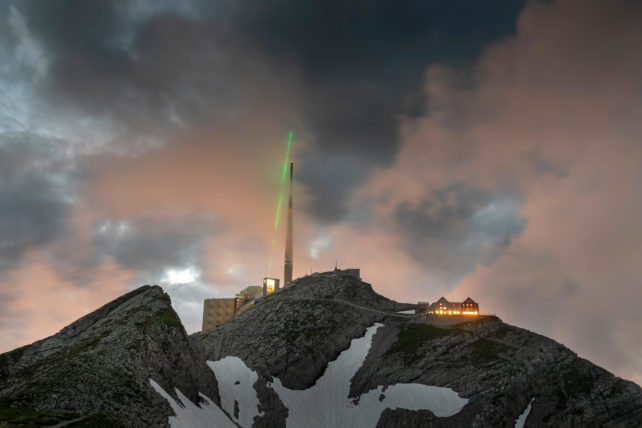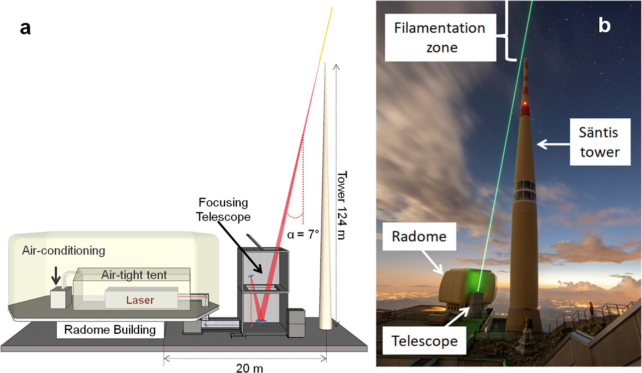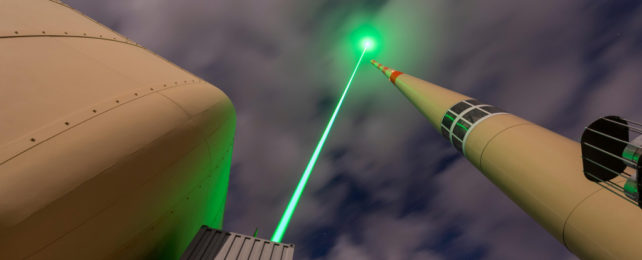Don't try this at home, but beaming a laser into the sky could avert lightning strikes, according to a new study from a team of scientists who experimented with the lasers atop a Swiss mountain where a great big metal telecommunications tower stands.
Physicist Aurélien Houard, from the French National Center for Scientific Research's Applied Optics Laboratory in Paris, and colleagues weathered hours of thunderstorm activity to test whether a laser could guide lightning strikes away from critical infrastructure. The telecommunications tower is struck by lightning about 100 times a year.
That's similar to the number of lightning flashes that strike planet Earth or crackle between clouds every second. Collectively, those strikes can cause billions of dollars of damage to airports and launchpads, not to mention people.
Our best protection against lightning strikes is a Franklin rod, nothing more than a metal spire invented in the 18th century by Benjamin Franklin, who discovered lighting strikes are zig-zagging bolts of electricity. Those rods connect to metal cables that run down buildings and anchor into Earth, working to dissipate lightning's energy.
Houard and colleagues wanted to devise a better way to protect against lightning strikes, fighting electricity with light.
"Although this research field has been very active for more than 20 years, this is the first field result that experimentally demonstrates lightning guided by lasers," they write in their published paper.
With an increase in extreme weather events driven by climate change on the radar, lightning protection is becoming increasingly important.
The experimental campaign ran over the summer of 2021 from Säntis mountain in northeastern Switzerland. Short, intense laser pulses were cast into the clouds during a series of thunderstorms and successfully diverted four upward lightning discharges away from the tower's tip.

Another 12 lightning strikes hit the tower during those thunderstorm periods when the laser was inactive.
On one occasion, when the sky was clear enough to capture the action on two separate high-speed cameras, a lightning strike was recorded following the path of the laser for 50 meters (164 feet).
Sensors on the telecommunications tower also recorded the electric fields, and X-rays generated to detect lightning activity and corroborate its path, which you can see reconstructed in the video below.
For an idea first put forward in 1974 and tested extensively in the lab, it's thrilling to see it finally work as designed in the real world. Several earlier field trials, one in Mexico and another in Singapore, had failed to find any evidence that lasers could deflect lightning strikes.
"These preliminary results should be confirmed by additional campaigns with new configurations," write Houard and colleagues.
While the researchers are still figuring out why the lasers worked in their trials but not in earlier experiments, they have a few ideas. The laser Houard and colleagues used fires up to a thousand pulses per second, much faster than other lasers used, allowing the green beam to intercept all the lightning precursors forming above the tower.
But the recorded laser events only appeared to divert positive lightning flashes, which are produced by a positively charged cloud and generate negatively charged upward 'leaders'.
So how does it work?
As Houard and colleagues explain in their paper, the laser sent skyward changes the light-bending properties of the air, causing the laser pulse to shrink and intensify until it begins to ionize air molecules. This process is called filamentation.
The air molecules are rapidly heated along the path of the laser, absorbing its energy, then expelled at supersonic speed. This leaves behind 'long-lived' channels of less dense air that offer a pathway for electric discharges.
"At high laser repetition rates, these long-lived charged oxygen molecules accumulate, keeping a memory of the laser path" for lightning to follow, the researchers write.

Meters-long electric discharges had been steered by lasers in the lab, but this is the first time the technique has worked in a thunderstorm. Laser conditions were adjusted so that the initiation of filamentary behavior started just above the tip of the tower.
"This work paves the way for new atmospheric applications of ultrashort lasers and represents an important step forward in the development of a laser-based lightning protection for airports, launchpads or large infrastructures," Houard and colleagues conclude.
The study was published in Nature Photonics.
